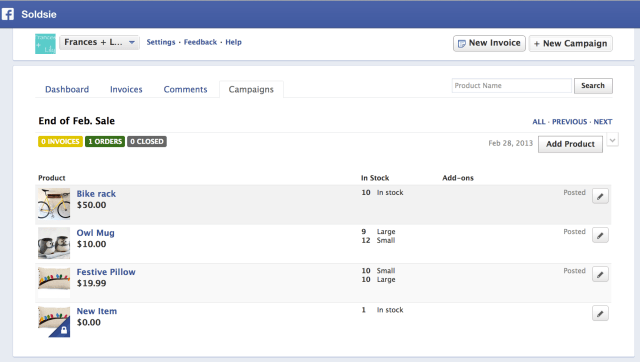E-commerce startup Soldsie, which just announced in January that it had raised $425,000 from 72 investors through FundersClub, has now officially closed its full seed round of $1 million in outside funding. In addition to FundersClub, the company raised from 500 Startups and e.ventures.
Investors in the round also included former Facebook employees Yun-Fang Juan (Soldsie Chief Scientist) and Jonathan Ehrlich (Copious), Peanut Labs founder Prosper Nwankpa, and angels Elliot Loh and Tom Kelly.
![soldsie_comments_mobile[1]](https://techcrunch.com/wp-content/uploads/2013/03/soldsie_comments_mobile1.png?w=169) When we first looked at Soldsie (previously Central.ly) last September, the company had just launched its social media “point-of-sale” product, which allows businesses to sell on Facebook using Facebook Comments. What that means is that a business owner could post a photo of an item they wanted to sell on their Facebook Page. Then, after first registering the Soldsie Facebook application, the page’s followers could purchase the item by typing in “sold.” After the initial purchase, the customer’s credit card information would be stored to make future transactions even easier.
When we first looked at Soldsie (previously Central.ly) last September, the company had just launched its social media “point-of-sale” product, which allows businesses to sell on Facebook using Facebook Comments. What that means is that a business owner could post a photo of an item they wanted to sell on their Facebook Page. Then, after first registering the Soldsie Facebook application, the page’s followers could purchase the item by typing in “sold.” After the initial purchase, the customer’s credit card information would be stored to make future transactions even easier.
At the time of our coverage, Soldsie had reached a million dollars in transactions across its platform. Today, the founders, Chris Bennett and Arrel Gray, tell us that Soldsie is seeing over a million in transactions per month. Over 100,000 customers have now bought through Soldsie, says Gray. The types of businesses using the service have also broadened a bit. In the past, the platform was primarily used to sell children’s clothing and women’s accessories, but now there are companies selling women’s fashion and home decor, as well. The average selling price of $25 still remains somewhat in the “impulse buy” range, however.
The company has been busy on product development in the last several months, having now fully automated the selling process for its merchants so that customers are automatically invoiced after writing “sold” in the comments. Gray notes that they’ve also added some automatic processing of the language in the comments, too. For example, a customer could write that they want three small red t-shirts and one medium blue shirt, and Soldsie would understand what they had ordered.
“As a merchant, you just fill out your inventory,” explains Gray, “and we’ll keep track of how many of each you’ve sold and when you’ve sold out, all based on the comments. You don’t have to manually go in and select anything.”
The company is also working on integration with other fulfillment and e-commerce platforms, too, including ShipStation (currently in beta), Stamps.com, and Shopify, for example. ShipStation will become available to all Soldsie merchants later this month, while other fulfillment platforms, as well as an open API, will be made available starting in April. Meanwhile, in terms of supporting additional e-commerce platforms, the goal is to make Soldsie another sales channel for merchants.
“We’re looking into plugging in more to e-commerce platforms so that you can actually manage your inventory,” Gray says. “So if you’re a Shopify seller, or you sell on other channels like Amazon or eBay, it’s easy to just add us.”
With the additional funding, the company will focus on continued product development and marketing initiatives, says Bennett. They’ll also grow the San Francisco-based team of now seven to include more engineers, as well as marketing and sales staff.
It’s interesting to see a startup engaging in so-called f-commerce gaining ground, when even Facebook itself is struggling to get people transacting on its site through new initiatives like Gifts. And big-name brands haven’t always had the best of luck with e-commerce stores on their Facebook Pages, either.
“We know that there are a lot of brands that we’ve talked to that have invested a lot of money and time into Facebook commerce, and haven’t seen the results that they would like to see,” says Gray. “We’re just really excited about what we’re building at Soldsie because we’re seeing success here, and we want to take what we’re learning and take it to brands all over the world.”
Adds Bennett, “social commerce isn’t as easy as just putting a buy button in a post on Facebook or a link on Twitter. Social commerce has to be rethought to be more social. By doing what we’re doing – letting people leave comments to make purchases – we’re tying the two together. It actually works the way Facebook works.”

